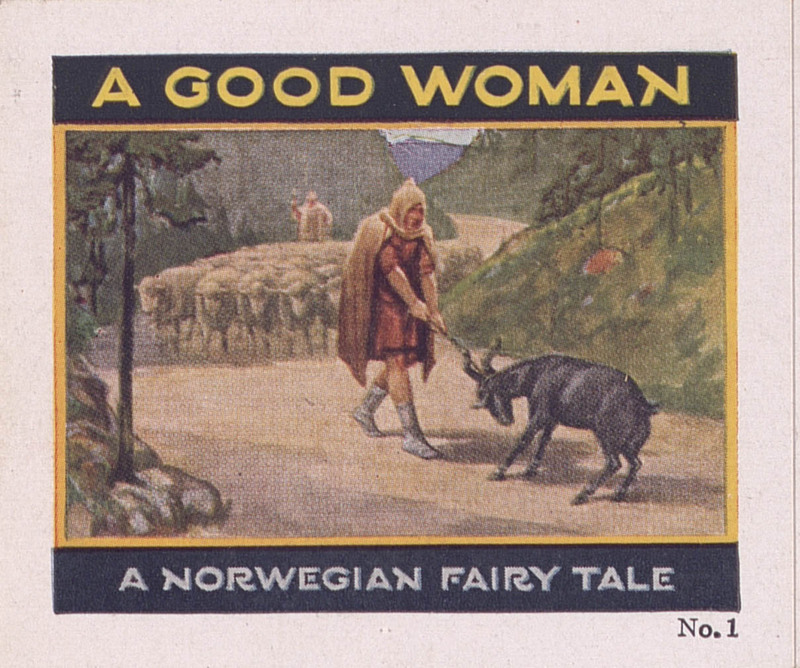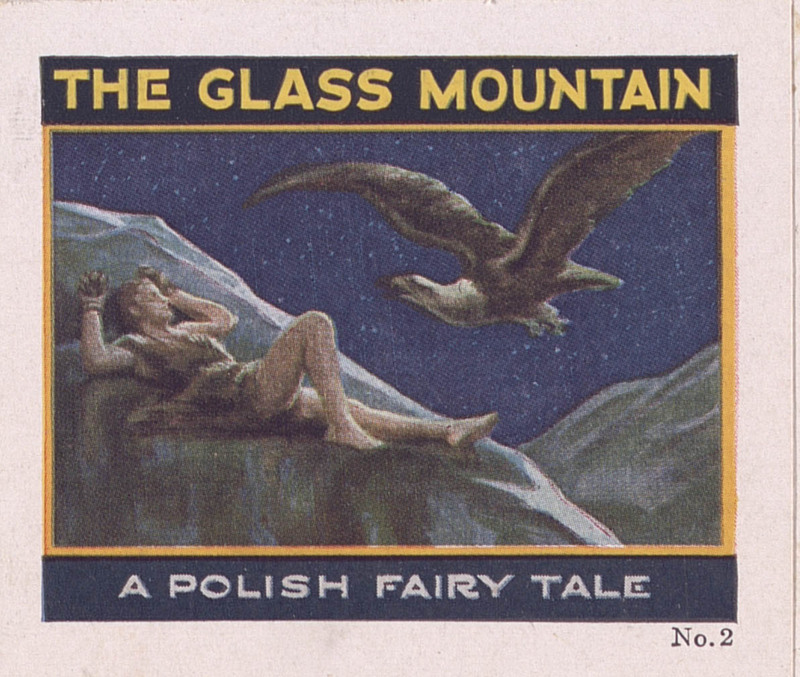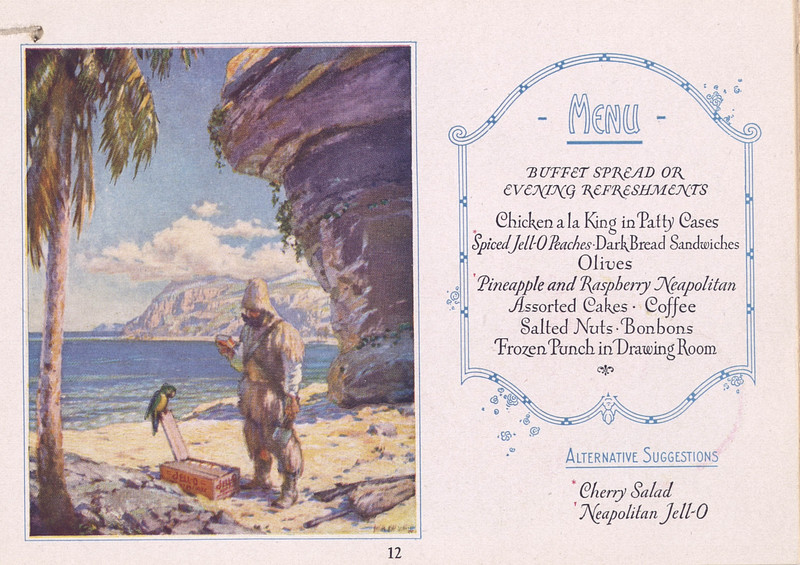Exotic Tales Overview
Advertising that reproduced in collectable small pamphlets fairy tales, folk tales, and exotic stories provided Jell-O with an imagined genealogy. That is, by affiliating Jell-O with traditional stories a comparatively young company associated itself witha past as timeless as the folk tale, and as magical as an enchanted golden crab. Fairy tales, popularized by Hans Christian Anderson and the Brothers Grimm, underwent something of a revival in the Progressive era, courtesy of popular collections such as Andrew Lang’s 12-volume “colored” Fairy Books. The moral lessons common to such tales fit well with Jell-O’s wish to provide authoritative advice on domestic matters. Recipes are partnered with the stories, collapsing the fantastical and the achievable. The logic, however, requires the magic to remain attached to the Jell-O – the act of advertising must remain transparent. Industrial capitalism repurposes traditional culture but Jell-O must still be recognizable and recognizably American.
Exotic Tales
Amidst recipes for Olive Jell-O Salad and Jell-O Horseradish Relish (Lemon Jell-O, vinegar, pimentos, green peppers and horseradish, set and served in slices with meat or fish) the unlikely tale of "A Good Woman" is told – “good” because she claims to believe everything her husband Gudbrand, does, is perfect. Gudbrand fails to sell his cow at market and exchanges it for items of ever-decreasing value - a skittish horse, a lazy pig, a boisterous goat, a troublesome goose, a rooster, and eventually a meal to ease his hunger - but his wife expresses only her pleasure that he had a cow to sell, was fed, and returned home. Gudbrand rewards “his old wife” with a kiss filled “with as much pleasure as if she had still been twenty.” "A Good Woman" was first published in English in 1888 (translation by George Webbe Dasent in Popular Tales from the Norse. Edinburgh: Douglas, 1888). The Jell-O version includes an illustration of Gudbrand struggling with a stubborn goat on a country road as a flock of sheep approach. It is the first in the fairy tale series.
The Glass Mountain was adapted from a European folk story popularized in Andrew Lang’s Yellow Fairy Book (1894). A fierce giant eagle protects the golden apple tree that controls access to a beautiful princess trapped in an enchanted castle on a glass mountain. A “youth” breaks the very enchantment by holding the eagle’s feet as it flies, cutting the eagle’s feet as it soars above the tree, allowing him to land in the tree, pick the golden apples, free and marry the princess and, of course, live happily ever after. The blood of the supernatural eagle brings back from the dead the prior suitors who had perished in their pursuit of the princess; when they realize the princess has been won they mount their horses and go “on their way in search of other adventures.” The tale is supplemented with recipes like Glorified Rice, and Mrs. Rorer’s Bavarian Cream. The latter, we are told, “effects a great saving in work and expense when contrasted with usual Bavarian Cream recipes.”
The complicated Greek folk tale "The Golden Crab", retold in Andrew Lang’s popular Yellow Fairy Book (1894) is simplified for this Jell-O pamphlet version. Briefly, a fisherman nets a golden crab, who when fed excretes gold and is really an enchanted prince. After passing a series of tests the crab marries a princess, to whom he reveals his true self. But her parents are unhappy with the human-crab match and try to arrange a second marriage and the princess unintentionally reveals his identity so he must instead live as an eagle. She finds him in eagle form and they are reunited in this vanishing-husband-tale. When his enchantment concludes they return to the palace and live happily ever after. Only four dessert recipes accompany this tale, including Neapolitan Jell-O. Mirroring the complexity of the fairy tale, this recipe requires a full page of directions (and an illustration on the back of the pamphlet) for multiple layers of different flavored Jell-O, some plain, some whipped (shown in Desserts of the World - A Russian Dinner in the “Imagining the Other” section of this exhibit.)
First published in 1843 by Hans Christian Andersen, "The Nightingale" is Danish in origin. An imagined Chinese Emperor becomes fixated on a sweetly singing nightingale in his palace. The Emperor of Japan sends a fantastic bejeweled mechanical version, and the Chinese Emperor loses interest in the real nightingale. Eventually the mechanical nightingale wears out but as the Emperor is dying, the living nightingale sings him to health, and becomes the Emperor’s counsel. In the cover illustration, the Emperor wears colorful robes and a golden crown, and sports a Fu Manchu moustache. This moustache style (made infamous by sensationalist fiction and film) came to symbolize an ‘Oriental villain.’ Cucumber salad (Lemon Jell-O, vinegar, salt, cucumber and green coloring, set and then cut into squares, served on cucumber or lettuce to accompany fish) completes this tale.
An untitled booklet from 1925 offers a series of menus for different social occasions, all of which feature Jell-O dishes. In one rather incongruous pairing, a menu for a “Buffet Spread, or Evening Refreshments” is illustrated by Angus MacDonall’s scene of Robinson Crusoe finding a case of Jell-O, complete with parrot (presumably Polly the parrot who accompanies the Jell-O Girl: see The Jell-O Girl In Greece in the “Jell-O Girl Adventures” section of this exhibit.) MacDonall, who was responsible for numerous Jell-O illustrations and advertisements, originally painted this work in 1920, though this 1925 version has a more sedate palette. As a castaway, Crusoe making Chicken a lá King in patty cases with assorted cakes seem particularly jarring. Crusoe appears to be considering the case of Jell-O perplexedly, apparently unsure about transforming his deserted island into one of just desserts.
Desserts of the World (1909) largely imagines food preparation and consumption around the world. The first full page illustration, however, is a scene from the garden of Eden, perhaps akin to the folk stories and fairy tales. Eve, modestly attired in a sleeveless, above the knee, dress of leaves, is about to pick the proverbial apple, watched by the snake and in the presence of a peacock. Below this scene sit three glasses of Apple Snow Jell-O and the phrase “JELL-O, The American Dessert.” A full recipe is given on the opposite page: the red of the forbidden apple is mirrored by strawberry Jell-O, the snow is made with beaten egg whites, sugar and grated apple. Presumably this is intended as a post-fall image, with Eve’s clothing signaling both her shame and the acceptability now of eating apples, especially in Apple Snow.
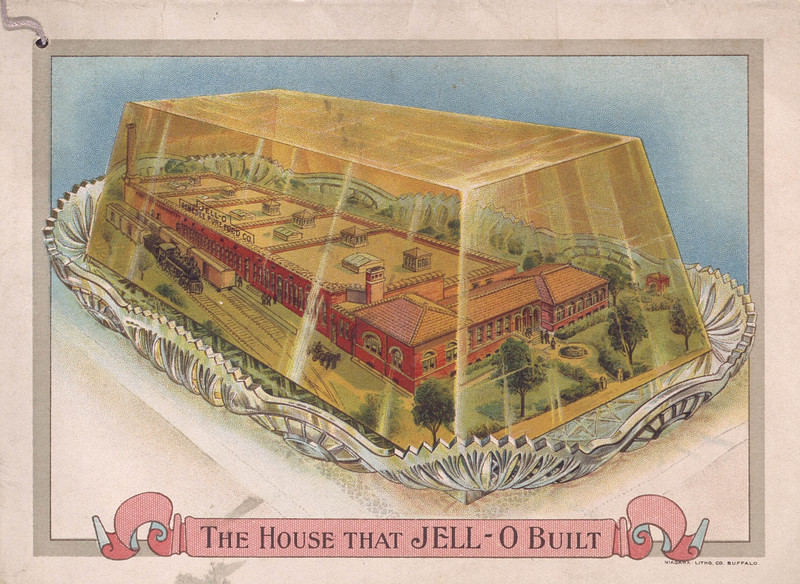
Production Overview
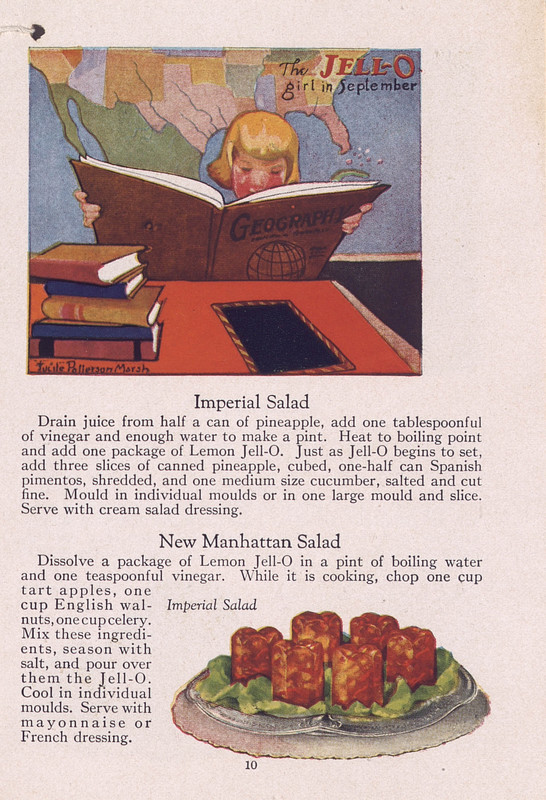
Jell-O Girl Adventures Overview

